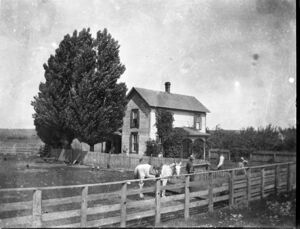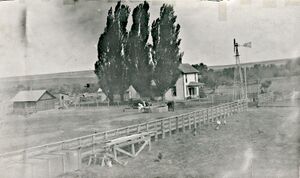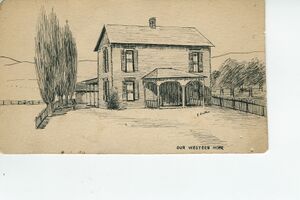Buckman Railroad Quarter (NE ¼ Section 17): Difference between revisions
(split chapters into individual articles) |
No edit summary |
||
| (8 intermediate revisions by the same user not shown) | |||
| Line 1: | Line 1: | ||
{{box|This article is part of a series. To find other articles, see [[Some South Reardan Homesteads]].}} | |||
John and Lizzie Buckman moved to the Reardan area in 1885 from Ohio. John met Luke Ensor on the train and together they decided that the area would be great for raising cattle. Rather than wait out homesteading requirements, John and Luke purchased some land: the SW ¼ of Section 8 from the US Government in 1891 and the NE quarter of Section 17 from the Northern Pacific Railway on 2 December, 1889. The Central Washington Railway was built through their Section 17 property and Reardan in 1888. They sold the right of way for the railroad in 1889. Luke Ensor dropped his claim to Section 8 in 1892. The two men transferred the Section 16 property to John’s wife Lizzie in March 1894. | John and Lizzie Buckman moved to the Reardan area in 1885 from Ohio. John met Luke Ensor on the train and together they decided that the area would be great for raising cattle. Rather than wait out homesteading requirements, John and Luke purchased some land: the SW ¼ of [[Buckman Other Quarter (SE ¼ Section 8)| Section 8]] from the US Government in 1891 and the NE quarter of Section 17 from the Northern Pacific Railway on 2 December, 1889. The Central Washington Railway was built through their Section 17 property and Reardan in 1888. They sold the right of way for the railroad in 1889. Luke Ensor dropped his claim to Section 8 in 1892. The two men transferred the Section 16 property to John’s wife Lizzie in March 1894. | ||
Washington Territory was anxious in 1885 to become a state, so it performed a census every year to know when it had enough citizens to achieve statehood, which it did in November of 1889. From these censuses we learn the names of the Buckman children. There were five girls: Grace, Gertie, Birdie, Mable and Mollie. After moving here, they had two more children, Florence and Charles. Charles who died shortly after birth in 1891 and Mable died at age 14 in 1894. Their eldest, Grace, married Fred Garber on December 20, 1893. Mollie married Russel Cassels in 1904. John, Lizzie, Charles, Mable, Grace and Mable are buried at Reardan. | Washington Territory was anxious in 1885 to become a state, so it performed a census every year to know when it had enough citizens to achieve statehood, which it did in November of 1889. From these censuses we learn the names of the Buckman children. There were five girls: Grace, Gertie, Birdie, Mable and Mollie. After moving here, they had two more children, Florence and Charles. Charles who died shortly after birth in 1891 and Mable died at age 14 in 1894. Their eldest, Grace, married Fred Garber on December 20, 1893. Gertie or Gertrude married Peter Nickolis Tramm on October 12, 1898. Mollie married Russel Cassels in 1904. John, Lizzie, Charles, Mable, Grace and Mable are buried at Reardan. | ||
The Buckman name kept coming up in the Mahrt family history. | The Buckman name kept coming up in the Mahrt family history. One such story was the story of the [[John Buckman Murder|John Buckman murder]] that occurred when the Mahrt were [[Threshing Wheat|threshing wheat]] at the Buckman place. | ||
[[ | |||
Life on the farm could be hard work and very lonely. Fred Mahrt’s wife Emma missed her family and the life she left behind in Wisconsin. So Fred and Emma invited her mother to come out for a visit. Emma’s mother had remarried and was in the process of raising a second family. William Frederick Mahrt (a son of Fred Mahrt) recalls in 1978 to his daughter Leah Mahrt: | Life on the farm could be hard work and very lonely. Fred Mahrt’s wife Emma missed her family and the life she left behind in Wisconsin. So Fred and Emma invited her mother to come out for a visit. Emma’s mother had remarried and was in the process of raising a second family. William Frederick Mahrt (a son of Fred Mahrt) recalls in 1978 to his daughter Leah Mahrt: | ||
“In the winter of 1896-7 Grandpa and Grandma [Henry and Anna] Meyer came out from Wisconsin [to Reardan, WA]. It was after New Years. Fred Mahrt took a bob sled to haul them out from Reardan. Had a whole bob sled full of people of the Meyer family. They stayed with us for three months. They had 3 boys and 4 girls [in addition to the four Mahrt children at that time]. We had a lot of fun. We slept on the floor all over the house. We has a lot of fun while Meyer’s lived with us. I don’t think they ever got through laughing. | <blockquote> | ||
[[file:1905-1915-otto-0086-buckman-place-1906-1600 (copy).jpg|thumb|right|The Buckman place in 1906.]]“In the winter of 1896-7 Grandpa and Grandma [Henry and Anna] Meyer came out from Wisconsin [to Reardan, WA]. It was after New Years. Fred Mahrt took a bob sled to haul them out from Reardan. Had a whole bob sled full of people of the Meyer family. They stayed with us for three months. They had 3 boys and 4 girls [in addition to the four Mahrt children at that time]. We had a lot of fun. We slept on the floor all over the house. We has a lot of fun while Meyer’s lived with us. I don’t think they ever got through laughing. | |||
“They moved to the Buckman place and farmed that place for about two or three years or longer. And then they bought ten acres of bottom land on the edge of Reardan. He had hogs and chickens and a cow or two and garden.” | “They moved to the Buckman place and farmed that place for about two or three years or longer. And then they bought ten acres of bottom land on the edge of Reardan. He had hogs and chickens and a cow or two and garden.” | ||
</blockquote> | |||
Henry and Anna and three of their children (Henry David Meyer, Ella Meyer Collis and Fred’s wife Emma Mahrt) are buried at the Reardan cemetery. Another son, Charles age 22, may also be buried at Reardan, as he died of Bright's liver disease, undifferentiated liver disease, in 1903. Henry died in 1920 also from Bright’s disease and Anna passed in 1931. | Henry and Anna and three of their children (Henry David Meyer, Ella Meyer Collis and Fred’s wife Emma Mahrt) are buried at the Reardan cemetery. Another son, Charles age 22, may also be buried at Reardan, as he died of Bright's liver disease, an undifferentiated liver disease, in 1903. Henry died in 1920 also from Bright’s disease and Anna passed in 1931. | ||
John Mahrt bought the Buckman place from the widow Lizzie Buckman in 1906. This is the same year Fred Mahrt's wife Emma died. | John Mahrt bought the Buckman place from the widow Lizzie Buckman in 1906. This is the same year Fred Mahrt's wife Emma died. | ||
[[File: | [[File: Koeller scan 0041-buckman-place-enhanced.jpg |thumb|left|Buckmman place around 1916 based on the car.]] | ||
In 1916 John sold to his sister and brother-in-law, Mary and William Koeller. While they lived at the Buckman place, many Emanuel Lutheran Church picnics where held in the so-called Koeller Grove. The Koellers appear to be living here in 1914, although they appear to be at the [[Prince Homestead Quarter (NE ¼ Section 30)|Prince place]] in 1910. | |||
In 1916 John sold to his sister and brother-in-law, Mary and William Koeller. While they lived at the Buckman place, many Emanuel Lutheran Church picnics where held in the so-called Koeller Grove. The Koellers appear to be living here in 1914, although they | |||
William and Mary’s son Roy married Helen Barline in 1921. They farmed this quarter and two more purchased by William and Mary Koeller, | [[file:1916-koeller-0042-ed-koeller-sketch-of-buckman-place.jpg |thumb|right||alt=”Our Western Home” sketch of the Buckman place by Edwin Koeller probably done around 1916.|”Our Western Home” sketch of the Buckman place by Edwin Koeller probably done around 1916.]]William and Mary’s son Roy married Helen Barline in 1921. They farmed this quarter and two more purchased by William and Mary Koeller, [[Koeller School Section (SW ¼ Section 16)|a school quarter]] and her brother [[Fred Mahrt Homestead Quarter (SW ¼ Section 20)|Fred Mahrt’s railroad quarter]]. At some point William and Mary moved to Reardan and Roy and Helen took over the house. They may have stayed until the land was redistributed upon the death of his parents in 1941. They moved to Sequim, WA where he initially managed a ranch and eventually sold insurance and retired. | ||
In 1941 the property then passed to Roy’s brother Emil, who in turn sold the land in 1963 to the Wendlandt family whose heirs own it today. | In 1941 the property then passed to Roy’s brother Emil, who in turn sold the land in 1963 to the Wendlandt family whose heirs own it today. | ||
{{box|This article is part of a series. To find other articles, see [[Some South Reardan Homesteads]].}} | |||
{{DEFAULTSORT: Buckman, John}} | |||
[[ | [[Category: Pioneer Stories]] | ||
Latest revision as of 09:55, 22 November 2022
This article is part of a series. To find other articles, see Some South Reardan Homesteads.
John and Lizzie Buckman moved to the Reardan area in 1885 from Ohio. John met Luke Ensor on the train and together they decided that the area would be great for raising cattle. Rather than wait out homesteading requirements, John and Luke purchased some land: the SW ¼ of Section 8 from the US Government in 1891 and the NE quarter of Section 17 from the Northern Pacific Railway on 2 December, 1889. The Central Washington Railway was built through their Section 17 property and Reardan in 1888. They sold the right of way for the railroad in 1889. Luke Ensor dropped his claim to Section 8 in 1892. The two men transferred the Section 16 property to John’s wife Lizzie in March 1894.
Washington Territory was anxious in 1885 to become a state, so it performed a census every year to know when it had enough citizens to achieve statehood, which it did in November of 1889. From these censuses we learn the names of the Buckman children. There were five girls: Grace, Gertie, Birdie, Mable and Mollie. After moving here, they had two more children, Florence and Charles. Charles who died shortly after birth in 1891 and Mable died at age 14 in 1894. Their eldest, Grace, married Fred Garber on December 20, 1893. Gertie or Gertrude married Peter Nickolis Tramm on October 12, 1898. Mollie married Russel Cassels in 1904. John, Lizzie, Charles, Mable, Grace and Mable are buried at Reardan.
The Buckman name kept coming up in the Mahrt family history. One such story was the story of the John Buckman murder that occurred when the Mahrt were threshing wheat at the Buckman place.
Life on the farm could be hard work and very lonely. Fred Mahrt’s wife Emma missed her family and the life she left behind in Wisconsin. So Fred and Emma invited her mother to come out for a visit. Emma’s mother had remarried and was in the process of raising a second family. William Frederick Mahrt (a son of Fred Mahrt) recalls in 1978 to his daughter Leah Mahrt:
“In the winter of 1896-7 Grandpa and Grandma [Henry and Anna] Meyer came out from Wisconsin [to Reardan, WA]. It was after New Years. Fred Mahrt took a bob sled to haul them out from Reardan. Had a whole bob sled full of people of the Meyer family. They stayed with us for three months. They had 3 boys and 4 girls [in addition to the four Mahrt children at that time]. We had a lot of fun. We slept on the floor all over the house. We has a lot of fun while Meyer’s lived with us. I don’t think they ever got through laughing.
“They moved to the Buckman place and farmed that place for about two or three years or longer. And then they bought ten acres of bottom land on the edge of Reardan. He had hogs and chickens and a cow or two and garden.”
Henry and Anna and three of their children (Henry David Meyer, Ella Meyer Collis and Fred’s wife Emma Mahrt) are buried at the Reardan cemetery. Another son, Charles age 22, may also be buried at Reardan, as he died of Bright's liver disease, an undifferentiated liver disease, in 1903. Henry died in 1920 also from Bright’s disease and Anna passed in 1931.
John Mahrt bought the Buckman place from the widow Lizzie Buckman in 1906. This is the same year Fred Mahrt's wife Emma died.
In 1916 John sold to his sister and brother-in-law, Mary and William Koeller. While they lived at the Buckman place, many Emanuel Lutheran Church picnics where held in the so-called Koeller Grove. The Koellers appear to be living here in 1914, although they appear to be at the Prince place in 1910.
William and Mary’s son Roy married Helen Barline in 1921. They farmed this quarter and two more purchased by William and Mary Koeller, a school quarter and her brother Fred Mahrt’s railroad quarter. At some point William and Mary moved to Reardan and Roy and Helen took over the house. They may have stayed until the land was redistributed upon the death of his parents in 1941. They moved to Sequim, WA where he initially managed a ranch and eventually sold insurance and retired.
In 1941 the property then passed to Roy’s brother Emil, who in turn sold the land in 1963 to the Wendlandt family whose heirs own it today.
This article is part of a series. To find other articles, see Some South Reardan Homesteads.


